Complete Solutions to Exercise of chapter ALDEHYDES, KETONES AND CARBOXYLIC ACIDS of Class 12 book with complete answers and questions
| Class 12 | CHEMISTRY |
| Chapter | ALDEHYDES, KETONES AND CARBOXYLIC ACIDS |
| NCERT | Exercise |
| Number Of Questions | 28 |
| Academic Year | 2023-24 |
Write the structures of the following compounds.
(i) `alpha`-Methoxypropionaldehyde
(ii) 3-Hydroxybutanal
(iii) 2-Hydroxycyclopentane carbaldehyde
(iv) 4-Oxopentanal
(v) Di-sec. butyl ketone
(vi) 4-Fluoroacetophenone04:00View SolutionWrite the structures of products of the following reactions,
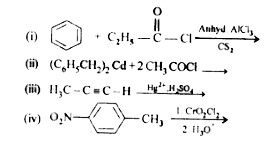 06:39View Solution
06:39View SolutionArrange the following compounds in increasing order of their boiling points.
`CH_(3)CHO,CH_(3)CH_(2)OH,CH_(3)OCH_(3),CH_(3)CH_(2)CH_(3)`02:53View SolutionArrange the following compounds in increasing order of their reactivity in nucleophilic addition reactions.
(i) Ethanal, Propanal, Propanone, Butanone.
(ii) Benzaldehyde, p-Tolualdehyde, p-Nitrobenzaldehyde, Acetophenone.
Hint: Consider steric effect and electronic effect.06:30View SolutionPredict the products of the following reactions:
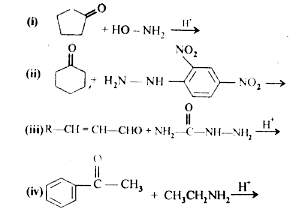 05:09View Solution
05:09View SolutionGive the IUPAC names of the following compounds:
(i) `"Ph CH"_(2)CH_(2)COOH`
(ii) `(CH_(3))_(2)C=CHOOH`
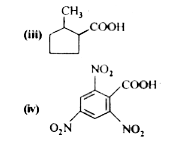 04:14View Solution
04:14View SolutionShow how each of the following compounds can be converted to benzoic acid.
(i) Ethylbenzene
(ii) Acetophenone
(iii) Bromobenzene
(iv) Phenylethene (Styrene)04:33View SolutionWhich acid of each pair shown here would you expect to be stronger?
(i) `CH_(3)CO_(2)H or CH_(2)FCO_(2)H`
(ii) `CH_(2)FCO_(2)H or CH_2ClCO_(2)H`
(iii) `CH_(2)FCH_(2)CH_(2)CO_(2)H or CH_(3)CHFCH_(2)CO_(2)H`
(iv) 06:16View Solution
06:16View SolutionWhat is meant by the following terms ? Give an example of the reaction in each case.
(i) Cyanohydrin
(ii) Acetal
(iii) Semicarbazone
(iv) Aldol
(v) Hemiacetal
(vi) Oxime
(vii) Ketal
(vii) Imine
(ix) 2,4-DNP-derivative
(x) Schiff’s base07:13View SolutionName the following compounds according to the IUPAC system of nomenclature:
i. `CH_(3)CH(CH_(3))CH_(2)CH_(2)CHO`
ii. `CH_(3)CH_(2)COCH(C_(2)H_(5))CH_(2)CH_(2)Cl`
iii. `CH_(3)CH=CHCHO`
iv. `CH_(3)COCH_(2)COCH_(3)`
v. `CH_(3)CH(CH_(3))CH_(2)C(CH_(3))_(2)COCH_(3)`
vi. `(CH_(3))_(3)C CH_(2)COOH`
vii. `OHC C_(6)H_(4)CHO-p`07:29View SolutionDraw the structures of following compound:
i. 3-Methylbutanal
ii. p-Nitropropionphenone
iii. p-Methylbenzaldehyde
iv. 4-Methylpent-3-en-2-one
v. 4-Chloropentan-2-one
vi. 3-Bromo-4-phenylpentanoic acid
vii. p,p'-Dihydroxybenzophenone
viii. Hex-2-en-4-ynoic acid05:34View SolutionWrite the IUPAC names of following ketones and aldehydes. Wherever possible, give common names also.
i. `CH_(3)CO(CH_(2))_(4)CH_(3)`
ii. `CH_(3)CH_(2)CHBrCH_(2)CH(CH_(3))CHO`
iii. `CH_(3)(CH_(2))_(5)CHO`
iv. `Ph-CH=CH-CHO`
v.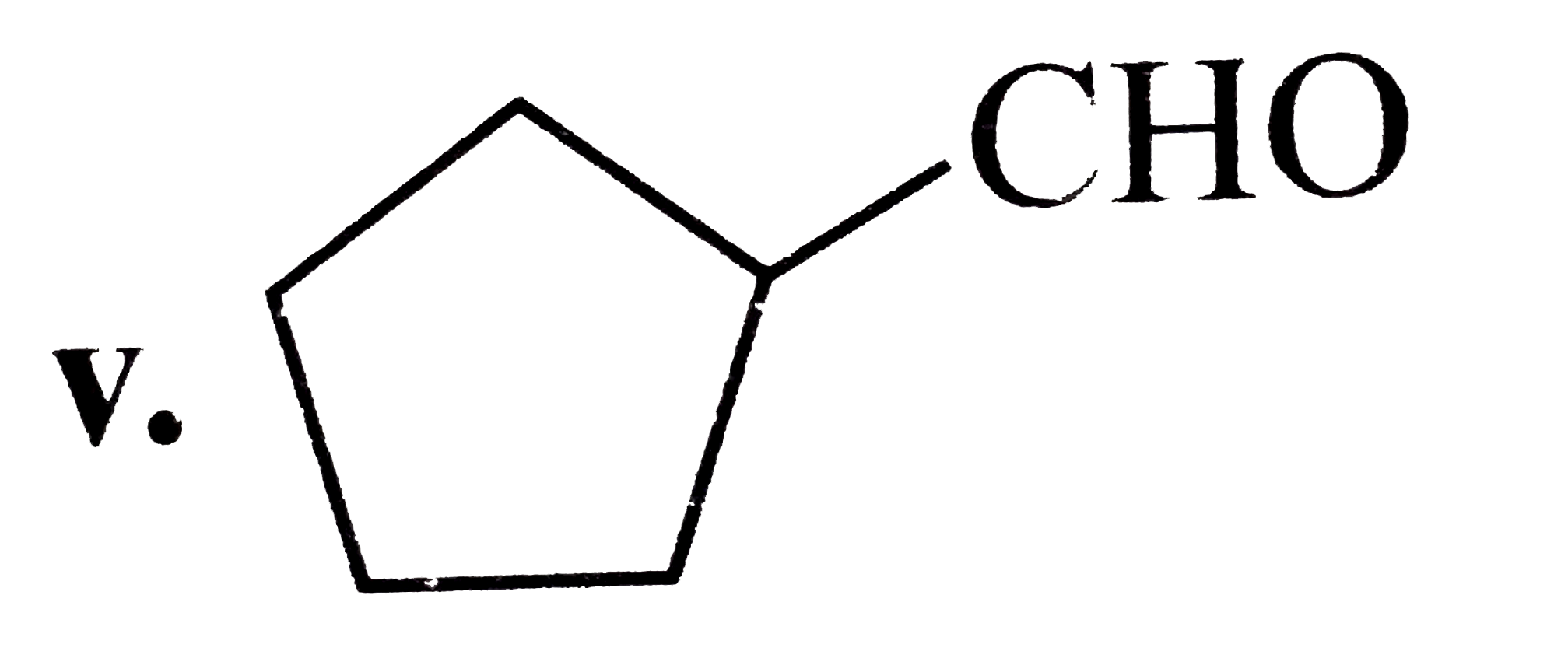
vi. `PhCOPh`06:03View SolutionDraw the structure of following derivatives:
i. 2,4-Dinitrophenylhydrazone of benzaldehyde.
ii. Cyclopropanone oxime
iii. Acetaldehyde dimethyl acetal
iv. Semicarbazone of cyclobutanone
v. Ethylene ketal of hexan-3-one
vi. Methyl hemiacetal of formaldehyde05:33View SolutionPredict the products formed when cyclohexane carbaldehyde reacts with the following reagents:
i. PhMgBr and then `H_(3)O^(+)`
ii. Tollens reagent
iii. Semicarbazide and weak acid
iv. Excess ethanol and acid
v. Zinc amalgam and dilute hydrochloric acid05:21View SolutionWhich of the following compounds would undergo aldol condensation or the Cannizzaro reaction, or neither? Write the structures of expected products of aldol condensation and Cannizzaro reaction.
i. Methanal ii. 2-Methylpentanal
iii. Benzaldehyde iv. Benzophenone
v. Cyclohexanone vi. 1-Phenylpropanone
vii. Phenylacetaldehye viii. Butan-1-ol
ix. 2,2-Dimethylbutanal12:57View SolutionHow will you convert ethanal into the following compounds ?
i. Butane-1,3-diol , ii. But-2-enal
iii. But-2-enoic acid03:13View SolutionWrite structure formulae and names of four possible aldol condensation products form propanal and butanal. In each case, indicate which aldehyde acts as nucleophile and which as electrophile.
07:30View SolutionAn organic compound with the molecular folmula `C_(9)H_(10)O` form 2,4-DNP derivative, reduces Tollens reagent, and undergoes Cannizaro reaction. On vigorous oxidation, it gives 1,2-benzenedicarboxylic acid. Identify the compound.
06:23View SolutionAn organic compound (A) (molecular formula `C_(8)H_(16)O_(2))` was hydrolysed with dilute sulphuric acid to give a carboxylic acid (B) and an alcohol (C ). Oxidation of (C ) with chromic acid produced (B). (C ) on dehydration gives but-1-ene. Write equations for the reactions involved.
05:30View SolutionArrange the following compounds in the increasing order of their property as indicated:
i. Acetaldehyde, acetone, di-tert-butyl ketone, methyl tert-butyl ketone (reactivity towards HCN).
ii. `CH_(3)CH_(2)CH(Br)COOH, CH_(3)CH(Br)CH_(2)COOH, (CH_(3))_(2)CHCOOH, CH_(3)CH_(2)CH_(2)COOH` (acidic strength).
iii. Benzoic acid, 4-nitrobenzoic acid, 3,4-dinitro-benzoic acid, 4-methoxybenzoic acid (acidic strength).10:20View SolutionGive simple chemical test to distinguish between the following pairs of compounds.
i. Propanal and Propanone
ii. Acetophenone and Benzophenone
iii. Phenol and Benzioc acid
iv. Benzoic acid and Ethyl benzoate
v. Pentan-2-one and Pentan-3-one
vi. Benzaldehyde and Acetophenone
vii. Ethanal and Propanal07:06View SolutionHow will you prepare the following compounds from benzene ? You may use any inorganic reagent and any organic one having not more than one carbon atom.
i. Methyl benzoate ii. m-Nitrobenzoic acid
iii. p-Nitrobenzoic acid iv. Phenylacetic acid
v. p-Nitrobenzaldehyde09:27View SolutionHow will you bring about the following conversions in not more than two steps ?
i. Propanone to propene
ii. Benzoic acid to Benzaldehyde
iii. Ethanol to 3-Hydroxybutanal
iv. Benzene to m-Nitroacetophenone
v. Benzaldehyde to Benzophenone
vi. Bromobenzene to 1-Phenylethanol
vii. Benzaldehyde to 3-Phenylpropan-1-ol
viii. Benzaldehyde to `alpha`-Hydroxyphenylacetic acid
ix. Benzoic acid to m-Nitrobenzyl alcohol12:39View SolutionDescribe the following
i. Acetylation
ii. Cannizzaro reaction
iii. Cross aldol condensation
iv. Decarboxylation08:27View SolutionComplete each synthesis by giving missing starting material, reagent or products
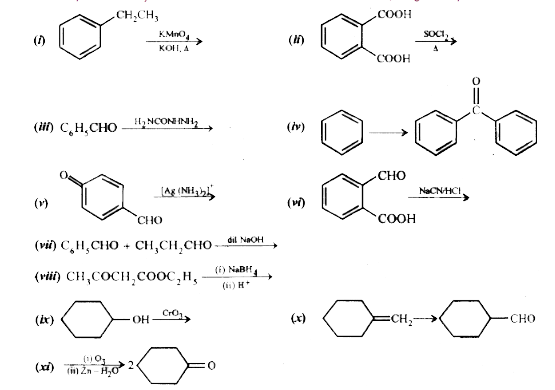 11:22View Solution
11:22View SolutionGiving plausible explanation for each of the following:
i. Cyclohexanone forms cyanohydrin good yield but 2,2,6-trimethylcyclohexanone does not.
ii. There are two `(-NH_(2))` groups in semicarbazide. However, only one is involved in the formation of semicarbazones.
iii. During the preparation of esters from a carboxylic acid and an alcohol in the presence of acid catalyst, the water or the ester should be removed as soon as it is formed.04:10View SolutionAn organic compound contains `69.77%` carbon, `11.63%` hydrogen, and rest oxygen. The molecular mass of the compound is 86. It does not reduce Tollens reagent but forms an addition compound with sodium hydrogensulphite and gives positive iodoform test. On vigorous oxidation, it gives ethanoic and propanoic acid. Write the possible structure of the compound.
06:04View SolutionAlthough phenoxide ion has more number of resonating structures than carboxylate ion, carboxylic acid is a stronger than phenol. Why ?
01:26View Solution
Exercise questions and complete solutions for chapter ALDEHYDES, KETONES AND CARBOXYLIC ACIDS of NCERT CHEMISTRY(HINGLISH) of Class 12
